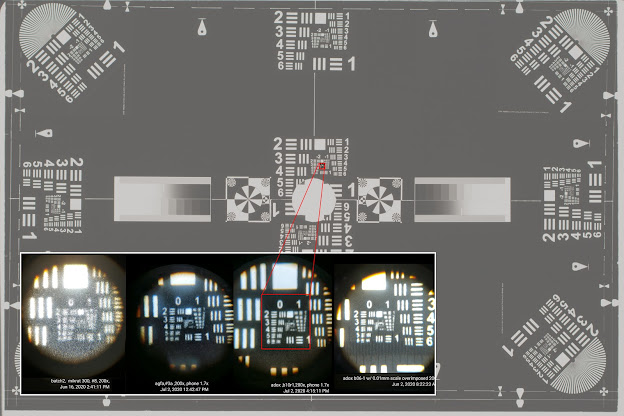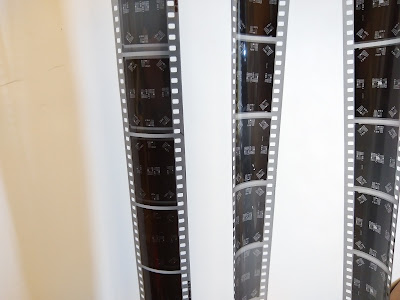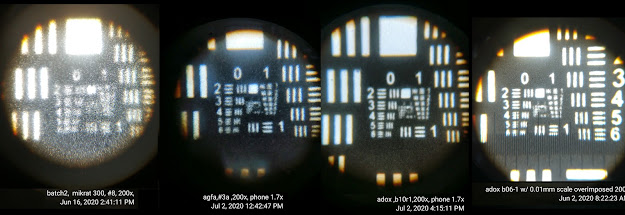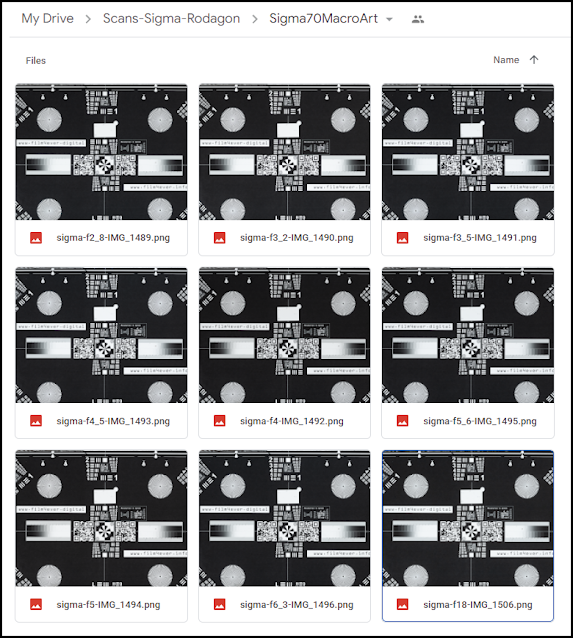In search for the Holy Grail of Film
To successfully assess DSLR scanning capabilities I needed 35 mm film which would not be outresolved even by the high-end digital camera. Of all the chart pieces the real drama happens right there - in parlance of USAF 1951 - at Group 0 (zero). Say, if Group 0 Element 5 to be resolved, the lens +film resolution should be at least 87 lp/mm (calculation are based on my USAF targets dimensions and the shooting distance/lens focal distance). Just think of it - you are in front of a chart 24x36 inches (60x90 cm) at normal viewing distance - say two feet - will you be able to see the strokes of size 0.3 - 0.5 mm ? If your vision is 20/20 you probably will, but barely. The same is true for the camera as we will see below. So what film we should use and how to get it? Even if film+lens give us say 90 lp/mm what your digital camera will be able to capture? Read on...
Even half a year ago, I was not familiar at all with the films sold nowadays in American stores. In B&H and Adorama prominent displays and refrigerators full of film gave way to ink cartridges and drones. I knew I needed Technical Pan sort of film and that was all I knew at the moment. Just couple of years ago at the annual Photo Expo Plus in NYC I observed a lonely Kodak representative with the box of free film no one wanted any more. I did not feel for him in slightest. When I came to America in 1998 and finally bought Canon Rebel 2000 camera I discovered that true expense was in the film and development. $5 for the roll of Velvia, $8 for the processing @ Dugal. Shooting slides - which I did most of my photo life - was barely affordable for someone making $50k a year. Most of the time I shot with "Fuji something:) 800 ISO". As few years passed the 6 MP digital cameras, memory cards and hard drives became quite affordable. When digital cameras started producing satisfactory pictures at ISO 800 and higher I did not shoot any film any more - I was confident that as a casual shooter digital gave me all the benefits and basically no drawbacks. Yes, rich, deep blues in shadows, transparent, realy airy clouds in the sky were gone with the slide film. Yes, oversharpened mountains' peaks have become separated from the skies by thin white lines, back-lit hair became a pixelated mess, hot spots on the cheeks and forehead became the signature of digital, eyelashes lost their crispness as well as eyes became sort of dull. Still I thought the sheer amount and low cost of shooting digital outweighed the loses and I looked at Kodak rep and smiled condescendingly.
But now (in December 2019) I needed film, and not just some film, but the highest resolution possible and of high contrast - by definition I needed microfilm or lith film. Back when I just started my photography exercises in former Soviet Union (SU) there were couple of films "Mikrat 300" and "MZ-3L" (the later can still be found in US these days). Mikrat was widely used in SU because that was go-to film when you needed a decent copy of the scientific article or of the banned book. There were no Xerox machines and even if they were somewhere they were guarded by KGB - seriously - the Xerox was considered as dangerous as a gun or spy's radio-transceiver.
Fast forward 30 years into Brooklyn apartment where I needed microfilm. In my search I stumbled upon FB group 'Vintage Film Shooters' and in no time I discovered the market for the long expired Soviet-era film stock. Films used to record the sound track like ZT6, cine stock Svema KN1, KN2, KN3 and other. I remember shooting Svema (or was it Tasma?) KN-1 back when it was almost fresh. It was available for free for us in the amather film studio, but as a cine stock it was so low contrast (gamma 0.65 i believe), that everything on it looked muddy and dead and high contrast papers in USSR were notoriously bad. And all those films were absolutely unforgiving if you touched emulsion while handrolling them. The film would emerge from the development tank and here they were - silvery spots where one touched the film with the knuckles of their sweety fingers.
MZ-3L was available in any store - no thrills high contrast film with the transparent base and without any anti-hallation layer. It was yellow as egg yolk on both sides and was considered a paper emulsion spilled on the film base. In fact it was used as a print stock for black and whites movies back then.
Finally there was Mikrat 300 - thick film with the green remjet layer, with presumed resolution of 300 lp/mm, with max density - well, the developed film rebate was as black and dense as the black paper they used to pack film in.
And so I did see that Mikrat 300 can be had for like 50 cents a foot - $2.50 a roll. I did like the price and seller was touting film as extraordinary fine grained even when pushed to some astronomical ISO numbers. Well I needed not any high ISO - ISO 12 would do for me fine as long as I can have resolution and contrast. I took the plunge and ordered the film, bulk film loader, unearthed few old ORWO cartridges with the famous lock in the spool and started ordering chemicals. Having chemicals delivered from beauty supplies, aquarionm shops, and plumber supplies store instead of Photographers' Formularly made my laugh. I choose to brew D19 - high contrast developer with 5 grams KBr - the amount of restrainer I felt I would need anyway for the film expired even before I decided to leave Svema factory behind. (Yes, Svema was not far away from my native city of Kharkov, Ukraine and sometimes the 1000 feet reels of film would mysteriously show up on Kharkov's photography flea market ;-) ).
So I printed the USAF patterns from the PDF found online, glued them to the board left after my daughter was done with her science projects at school, ordered film, received it promptly, - and kicked of the shutter. I bracketed wide enough to get into the vicinity of the proper exposure be the film ISO 1 or 100. When the film emerged from the fixing bath it was mercilessly fogged, not only fogged but it was probably stored in black paper which became so fragile over the years that it started allow light through the cracks.
I was disappointed, but that was my first roll of film developed at home after thirty years of hiatus. I decided to give it another try: cold developer (60 F) + some benzo. The roll came out less fogged and less of the film was fogged by cracks in the paper. Still it was too foggy so I decided to try the Farmer's weaker. I needed my pattern strokes to be transparent enough to achieve enough contrast. I did not need halftones, if certain density is removed to clear the darks in my pattern, it was fine. The trick did work - after 90 seconds in Farmer's weakener the film base became almost transparent. While studying negatives I realized they are not sharp across the frame. My camera was not aligned with my board properly and perspective was not right.
I forgot to mention that in hope to achieve the uniform sharpness across the frame, I mounted the enlarger lens Schneider Componon-S 5.6/100 on old Russion M42 bellows which were attached to old East German Praktika LTL3 camera. Focusing the lens became major issue. At the time my chart did not have any feature specifically intended to help with the lens focusing (I added Siemens stars for that in version 2). I strained my eyes as much as I could, but never had clear impression that focus has been achieved.
So here I was: unevenly fogged film, negatives only partially sharp, and no guarantee whatsoever that I would not need to refocus after each film change. It was good time to abandon the effort - and no one would ever asked where all my enthusiasm went. But after all, I spent so much time with film photography and I believed I knew thing or two about the process so giving up would certainly punch a big blow to my perception of myself as the old pro.
First I decided to switch gear - I went on and bought the camera of my dreams twenty years earlier - Canon Elan 7e for hefty 60 bucks, I bought helicoid ($32) and EF adapter so I now can mount Componon lens on my camera. I started thinking about geometry and how to line things up (that is subject of another post).
Another shoot and results were not great. I studied film under microscope I bought on Amazon specifically for that exercise and was disappointed that sharpness was not there and even after couple of focusing from scratch I could not get my chart sharp. It was time to abandon the ship - or get a better film.
The film landscape looked weird for me. The film fad has overtaken many FB groups. I had strong impression that folks ran out of Instagram filters and decided to go the route guaranteeing bragging rights - shoot film. The cottage industry of film sellers span up. I get slightly nauseous when I saw Lomography offerings - film for the hipsters - already fogged and completely of color balance. That was not a film - it was weird filter which happened to have emulsion over it. When I saw video tutorial from seem like an experienced folk who was touting C41 processing at home - and never once mentioned thermometer - I stopped looking at those sites and those expired films repackaged in candy-colored cartridges.
Still I learned about Kodak Techno Pan - which sounded right to me, Kodak Lith, Agfa Copex Rapid and Adox CMS 20. All films except Adox are long discontinued and I realized that the they probably fogged enough to make my effort worthless. I wanted to order Adox, but in February all stores on East Cost were out of stock. Eventually I secured few rolls of Adox CMS and Agfa Copex Rapid and shot another bracketed dozen. Well now I was really excited - never before I dealt with such film as Adox. Agfa looked promising too - well ... until I looked at the negs under 200x microscope.
Just for fun of it here is the comparison of said films Mikrat - Agfa - Adox under microscope at 100x.
So Adox certainly was the way to go, but to my chagrin that film showed with all the clarity that my lens Componon-S was not for the task - maybe it actually was, but I could not focus it reliably. At F5.6 you don't see enough in analog camera. Buying magnifying eyepiece was something I wanted to avoid and my expenses clearly were exceeding anything I budgeted when started. Well, if your hobby is not burning the hole in your pocket - it's not a hobby, but a fad. So I decided to switch to Canon lens with AF. And that was it - I was able to resolve elements which gave me resolution around 80 lp/mm - more than enough for the task at hand - creating target for DSLR scanning.
The last picture in the row shows very fine ruler with divisions each 0.01 mm - meaning it represents resolution 100 lp/mm. That means that Adox CMS 20 is truly remarkable film and that's why the targets became so popular among those who scan with their cameras.













Comments
Post a Comment